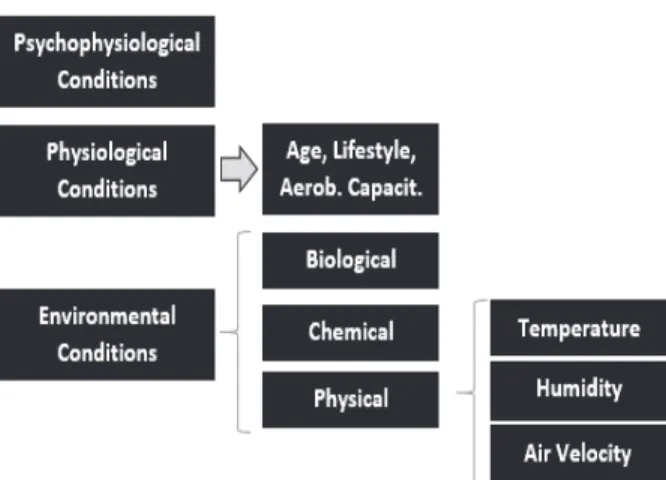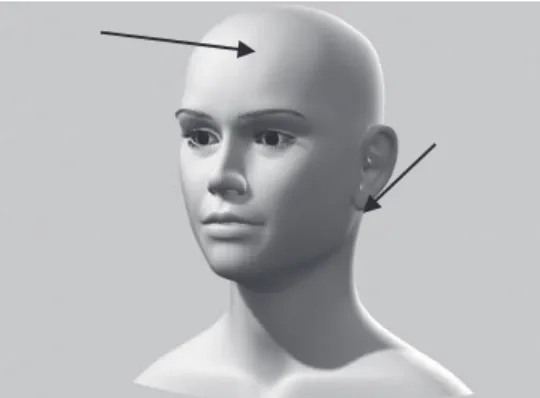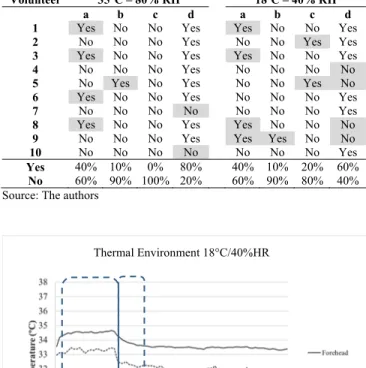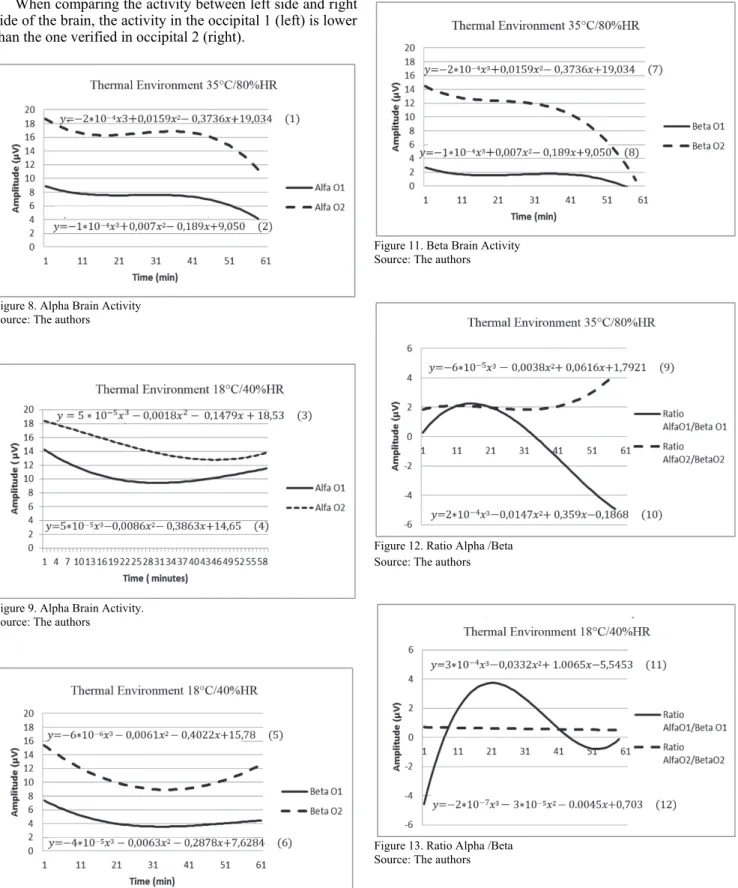© The author; licensee Universidad Nacional de Colombia.
Changes in EEG amplitude (Alpha and Beta waves) with Thermal
environment
1Emanuel Tiago-Costa a, Emília Quelhas-Costa b & João Santos-Baptista c a,b,c Research Laboratory on Prevention of Occupational and Environmental Risks (PROA), Porto, Portugal
b,cAssociated Laboratory for Energy, Transports and Aeronautics (LAETA), Faculty of Engineering, University of Porto, Porto, Portugal. a ega08027@fe.up.pt; b eqc@fe.up.pt, c jsbap@fe.up.pt
Received: November 30th, 2015. Received in revised form: March 17th, 2016. Accepted: April 25th, 2016.
Abstract
When executing a task, brain activity can be observed through electric waves recorded in different frequency bands. The main ones are the Alpha, Beta, Theta and Delta waves. According to some authors, Alpha and Beta waves are related with cognitive capacity and, their presence and evolution, with an individual’ alertness. In this study, the intention was to evaluate how brain activity is directly influenced by temperature and humidity while performing a task. Therefore, a set of laboratory tests were undertaken to simulate sedentary work in two different thermal environments: 18ºC - 40% RH (cold) and 35ºC - 80% RH (hot). In the hot thermal environment, oscillation on Alpha waves amplitude suggests an alternation between periods of tiredness with periods in which concentration increases. Regarding Beta waves in the cold thermal environment, most of the time Beta activity is typically higher than that verified in the hot thermal environment. Keywords: Alpha waves, Beta waves, thermal environmental, cognitive capacity.
Cambios en la amplitud del EEG (ondas Alfa y Beta) con el medio
ambiente térmico
Resumen
Cuando se ejecuta una tarea, puede observarse actividad cerebral através de las ondas eléctricas en diversas bandas de frecuencia. Los principales son las ondas Alfa, Beta, Theta y Delta. Según algunos autores, las ondas Beta y Alfa están relacionados con la capacidad cognitiva y, su presencia y evolución, la aparición y evolución, con el estado de alerta de un individuo. En este estudio, la intención fue evaluar cómo actividad cerebral está directamente influenciada por la temperatura y humedad mientras realiza una tarea. Por lo tanto, se llevaron a cabo un conjunto de pruebas de laboratorio para simular trabajo sedentario en dos diferentes ambientes térmicos: 18 ºC - 40% RH (en frío) y 35 ºC - 80% RH (caliente). En el ambiente térmico caliente, la oscilación de amplitud de las ondas alfa sugiere una alternancia entre periodos de cansancio con los períodos en que aumenta la concentración. Con respecto a las ondas Beta en el ambiente térmico frío, la mayoría de la actividad Beta es típicamente mayor que el verificado en el ambiente térmico caliente.
Palabras clave: ondas Alfa, ondas Beta, ambiente térmico, capacidad cognitiva.
1. Introduction
1.1. Occupational risk and thermal environmental
The economic and social development that has taken place throughout the 20th century has been accompanied by a greater awareness of work safety and health problems and
How to cite: Tiago-Costa, E., Quelhas-Costa, E. and Santos-Baptista, J., Changes in EEG amplitude (Alpha and Beta waves) with Thermal environment. DYNA 83(197), pp. 87-93, 2016.
also by the development of protective measures for workers. The objective has been to minimize risk. Despite these efforts, there are still working situations that can be very harmful to workers’ safety and health. One of these situations is related to workers who perform activities in “extreme” thermal environments, even if these are sedentary activities. It is pertinent to assess the relationship between thermal
Figure 1. Influence of different conditions in human ability. Source: [10].
environment and cognitive capacity since all human activity is influenced by the surrounding environment, including working activities. This allows the question of how thermal environment influences human being’s responsiveness to be clarified. Over the course of undertaking this research, we found several studies on the subject that have been performed in controlled environments, such as climatic chambers [1-5]. Furthermore some of the relevant literature [6,7] states that thermal environment can have a negative impact on performance, particularly when combined with other variables such as exposition time or task duration.
With increased technological development the workplace assumes a greater complexity. This increased complexity often brings additional risks for workers. Increasing technological complexity requires, from the worker, an increased cognitive performance, which may be jeopardized due to an inadequate thermal environment.
1.2. Influence of environment in human ability
The way that each individual feels the surrounding environment is influenced by intrinsic and extrinsic factors from the individual himself [8,9]. Tolerance to environment depends directly on, among others factors, age, aerobic capacity, hours of rest, lifestyle and consumption of medicines. These factors can be classified as shown in Fig. 1.
All of these strongly influence the feeling of well-being. The psychophysiological and physiological factors mean that different individuals in similar environmental conditions feel the conditions to which they are exposed differently.
1.3. Characterization and interpretation of brain waves
Monitorization and interpretation of brain waves can clarify how cognitive capacity is influenced by the thermal environment. The different types of brain waves / activities are:
• Delta Activity– is referred to as a "slow wave"; it is in the frequency range between 0.5 Hz and 4 Hz. This type of activity is recorded in the transitional phase for sleep and during sleep [11].
• Teta Frequency– this lies between 4 Hz and 7 Hz. Itis
associated with different psychological states, which include low levels of alertness and, consequently, is associated with the decrease in the capacity to process information. Theta frequency can also be considered a "slow wave" [12].
• Alpha waves– This type is dominant in adult human brains, and has a frequency of between 8 Hz and 13 Hz. The waves´ presence is common in the occipital cortex, during the period of wakefulness. Whenever the eyes are closed, the presence of this type of waves is common. When head wavers due to fatigue occurs, and when trying to be aware, Alpha wave activity decreases [11]. The presence of these waves during when the individual is awake and in a state of relaxation, leads to a slow response to stimuli [13].
• Beta waves– These have a frequency of between 13 Hz and 30 Hz, which indicates a high propagation speed. Their presence is associated with a state of arousal/alert. Beta activity can occur in humans while performing a motor task that requires high reaction time [14].
This study aims to contribute by establishing a relationship between thermal environment, and the signal amplitude of brain waves (Alpha and Beta), in particular the cognitive performance of individuals under uncomfortable environmental conditions.
2. Materials and Method 2.1. Main equipment
Monitoring and data collection was done using specific equipment. Table 1 presents the equipment that was used and its respective functions. After all the equipment [15] to be used was selected, each piece was tested and validated under trial protocol [16].
2.2. General trial conditions
The relationship between cognitive capacity, thermal environment and brain waves was evaluated by performing experimental trials with 10 male volunteers. Their ages were between 18 and 36 years old, with an average of 26±6 years. In these trials, each volunteer performed two cognitive tests. The first was held at 18ºC - 40% RH, and the second was done seven days later at 35ºC - 80% RH. All the trials were performed between 6:00 pm and 8:00 pm. The operating conditions were simulated within a Climate Chamber with an error of ±1ºC and ±2% RH.
Table 1.
Equipment used in laboratory tests.
Equipment Function
Brain-sensors (Emotiv Epoc – EEG*) Monetarization of brain activity Climatic
Chamber (Fito-Clima 2500EC20) Simulation of thermal environments Internal
Thermal Sensor
(Vital Sense) Monetarization of core temperature Skin Thermal
Sensors
(BioPlux) Monetarization of skin temperature * electroencephalogram.
Figure 2. Neck and forehead points to control the skin temperature. Source: [18]
Figure 3. Emotiv equipment and the respective signal. Source: www.engr.ucr.edu
Each volunteer was submitted to each one of the environmental conditions for 60 minutes after a stabilization period of 20 minutes outside the chamber (in the laboratory) at a temperature between 20ºC and 22ºC and a relative humidity between 55% RH and 65% RH. After this period, the volunteer who entered the climatic chamber waited for 10 minutes under environmental test conditions before beginning the essay. These 10 minutes were used to install an EEG device on the volunteer´s head. The total time for each experiment was 90 minutes. Control of skin temperature was undertaken at two points, one on the neck and the other on the forehead of the volunteer, as shown in Fig. 2. In all the tests, all volunteers were dressed with 0,7 clo.
For the trials at 35ºC - 80% RH, core temperature was also controlled. In total were conducted 20 tests. Skin temperature allowed individual stabilization to be controlled. Core temperature allows signs of thermal stress to be identified, especially when the organism was exposed to high temperatures (35ºC - 80% RH) [19]. This monitoring also allows the risks of excessive exposure to heat to be minimized.
To evaluate brain activity we used a specific interface (brain computer interface) that allowed Alpha and Beta waves to be registered. Only brain waves from the left and right occipital were studied. The occipital lobe is related to the visual sense and to the ability to process information and understanding its contents.
All selected volunteers were male. To obtain a high-quality signal, all electrodes must be connected (in green), as is shown in Fig. 3.
Volunteers’ cognitive capacity was stimulated by performing a "game/task". Each individual had to follow the
Figure 4. Go/No-Go test image. Source: [20]
given instructions. Each volunteer undertook a one hour task, in this case, the Go / No-Go test [20] (Fig. 4) and completed it as successfully as possible. Go/No-Go is a selective attention test that does not have learning effects over the results as is totally random.
Before starting the test, we explained what we intended to happen and the risks to the volunteer and an informed consent was signed. The study was approved by the Ethics Committee of the University of Porto (nº04 CEUP/2012).
2.3. Questionnaires
Before entering the Climate Chamber the volunteer answered 4 questions in order to assess their lifestyle, namely: a -Ingested caffeinated drinks in the last 12 hours?;
b -Ingested alcoholic drinks in the last 12 hours?; c - Any
medicine taken?; d - Good overnight rest?
These questions are relevant as they allow us to know if the volunteer is tired at the beginning of the test and, therefore, if task performance could be affected by other factors in addition to temperature and humidity.
Once the test was completed (1 hour), all the equipment was turned off, and the volunteer leaves the Climatic Chamber.
3. Results and discussion 3.1. Lifestyle
The answers given by the volunteers about their lifestyle before starting the tests helped to interpret the results (Table 2). Lifestyle can interfere with the results, for example, disguising fatigue (coffee) or reducing concentration power (alcohol).
Although some volunteers had a lifestyle that may influence the results (gray in Table 2), i.e. inserting biases in the results, we decided to include them if they are usual consumers of small doses.
3.2. Skin and core body temperature
Fig. 5 shows the evolution of the skin temperature average in the forehead and neck at 18ºC - 40% RH for the ten volunteers. Fig. 6 shows the evolution of skin temperature
average at 35ºC - 80% RH at the same skin points. In both environments, skin temperature stabilizes. This level is clearer on the forehead and for hot temperatures. It is also interesting to notice that in hot environments, on both control points, neck and forehead, the temperature value has almost the same value after stabilization.
The core body temperature that was measured only in the hot environment (35ºC - 80% RH) shows a great stability over time (Fig. 7).
Table 2.
Lifestyle Assessment for each volunteer.
Volunteer 35°C – 80% RH 18ºC – 40% RH
a b c d a b c d
1 Yes No No Yes Yes No No Yes
2 No No No Yes No No Yes Yes
3 Yes No No Yes Yes No No Yes
4 No No No Yes No No No No
5 No Yes No Yes No No Yes No
6 Yes No No Yes No No No Yes
7 No No No No No No No Yes
8 Yes No No Yes Yes No No No
9 No No No Yes Yes Yes No No
10 No No No No No No No Yes
Yes 40% 10% 0% 80% 40% 10% 20% 60%
No 60% 90% 100% 20% 60% 90% 80% 40% Source: The authors
Figure 5 Forehead and neck mean temperature Source: The authors
Figure 6 Forehead and neck mean temperature Source: The authors
Figure 7 Core body temperature average at 35ºC80%RH Source: The authors
3.3. Brain activity
Figs. 8 to 11 represent the average results for recorded brain activity. When Figs. 8 and 9 are compared with the Figs. 10 and 11, it is possible to confirm thermal environmental influence on brain activity (Alpha and Beta waves’ amplitude). For the colder environment (18ºC - 40% RH) Alpha activity is far superior to that obtained in the hot environment (35ºC - 80% RH). This excludes the occasionally-raised hypothesis that the perspiration is the main cause of the occurrence of high values of the EEG signal for hot environments.
In a state of wakefulness in which the volunteers are concentrated (eyes open), Alpha activity is usually small. As individuals become fatigued Alpha, activity is expected to increase. However, when time goes on, in the case of the trials at 35ºC - 80% RH (Fig. 8), only a small decrease in Alpha activity can be observed, which does not verify the expected trend. For the trials at 18ºC and 40% RH (Fig. 9), there is a decrease in Alpha activity in the first part of the test (20-30 min); this then increases until Alpha activity maintains values that are close to the initial values. The increase in Alpha activity suggests an increase of tiredness/fatigue in the volunteers.
Another relevant fact is the discrepancy of activity between the right and left brain hemispheres for hot thermal environments. In the left area of the brain (occipital 1) the range values activity is between 4-9 µV while in right area (occipital 2) this range rises to 11-19 µV (Fig. 8). It seems that in a hot thermal environment the temperature and relative humidity affect the left and right hemispheres differently.
According to several studies [11], Beta activity is considered the one that best describes alertness/arousal.
In a cold thermal environment, Beta activity is typically higher than the activity verified for the hot thermal environment.
It is usually considered that a decrease in Beta activity is related to the loss of the ability to concentration (reduction of surveillance), which was be verified throughout the trial. It is therefore possible to consider that cold thermal environments (Fig. 10) are conducive to higher levels of concentration/alertness than hot environments (Fig. 11).
Thermal Environment 18°C/40%HR
Thermal Environment 35°C/80%HR
When comparing the activity between left side and right side of the brain, the activity in the occipital 1 (left) is lower than the one verified in occipital 2 (right).
Figure 8. Alpha Brain Activity Source: The authors
Figure 9. Alpha Brain Activity. Source: The authors
Figure 10. Beta Brain Activity Source: The authors
After analyzing the data of brain activity for the two frequency bands (Alpha and Beta) it is possible to calculate the Alpha/Beta ratio. This ratio is developed to relate the two
Figure 11. Beta Brain Activity Source: The authors
Figure 12. Ratio Alpha /Beta Source: The authors
Figure 13. Ratio Alpha /Beta Source: The authors
most relevant frequencies, which facilitates understanding of the evolution of individual´s cognitive state.
With the analysis of the Alpha /Beta ratio, it is possible to observe the evolution of fatigue/tiredness over time. Theoretically an increase in fatigue levels over the trial time is expected, and the consequent tendency is to increase the Alpha/Beta values ratio.
Table 3
Values of the amplitude averages for the different waves over time in each hemisphere Alfa O1 Alfa O2 Beta O1 Beta O2 AlfaO1/ BetaO1 AlfaO2/ Beta O2 18ºC40%RH 10,8µV 14,6 µV 4,9 µV 11,5 µV 2,1 µV 0,6 µV 35ºC80%RH 7,4 µV 16,7 µV 1,5 µV 12,5 µV 1,5 µV 2,1 µV
Source: The authors
However, this expectation was only applied to the occipital 2 for 35ºC - 80% RH (Fig. 12) and very dimly at the end of the test in the cold thermal environment in occipital 1 (Fig. 13).
Interpreting Alpha and Beta wave activity still lacks scientific unanimity. It is commonplace that different studies reveal completely diverse results and interpretations. Some authors report that Alpha waves show changes at different temperature [21], and others report that alpha and beta increase at either 17ºC or 28ºC [4].
A comparison of both hemispheres can be seen in Table 3; when the average amplitude of Alpha waves increases, there is a decrease in the amplitude of Beta waves. This concurs with Eoh et al.´s results [22].
4. Conclusions
In hot thermal environment Alpha activity tends to decrease over the course of the task/test, for both areas of the occipital lobe. In the cold thermal environment, Alpha activity decreases for half the time of the test (30 min) and then rises, showing an increase for both areas of the occipital lobe. This means that a bigger effort was made.
Beta activity for the hot thermal environment is quite
small on the left side of the occipital lobe (Fig. 10 and Table 3); a downward activity is shown as the task was being developed. In tests undertaken in a cold thermal environment,
Beta activity decreases for approximately half of the test time
(30 min), and then it tends to increase at the end of the trials. The results support the idea that the different areas of the brain, in this case the left and right occipital lobes, are affected differently by the same environmental conditions.
Acknowledgements
The authors acknowledge the Master´s program in Occupational Safety and Hygiene Engineering at the Faculty of Engineering, University of Porto, and the Research Laboratory on Prevention of Occupational and Environmental Risks (PROA) for their financial support.
References
[1] Gaoua, N., Racinais, S., Grantham, J. and El Massioui, F., Alterations in cognitive performance during passive hyperthermia are task dependent. International Journal of Hyperthermia, 27(1), pp 1-9. 2011. DOI: 10.3109/02656736.2010.516305
[2] Hashiguchi, N., Feng, Y., and Tochihara, Y., Gender differences in thermal comfort and mental performance at different vertical air temperatures. European Journal of Applied Physiology, 109(1), pp 41-48, 2010. DOI: 10.1007/s00421-009-1158-7
[3] Lan, L., Lian, Z., Pan, L. and Ye, Q., Neurobehavioral approach for evaluation of office workers' productivity: The effects of room
temperature. Building and Environment, 44(8), pp. 1578-1588 2009. DOI: 10.1016/j.buildenv.2008.10.004
[4] Lan, L., Lian, Z. and Pan, L., The effects of air temperature on office workers' wellbeing, workload and productivity-evaluated with subjective ratings. Appl Ergon, 42(1), pp. 29-36 2010. DOI: 10.1016/j.apergo.2010.04.003
[5] Racinais, S., Gaoua, N. and Grantham, J., Hyperthermia impairs short-term memory and peripheral motor drive transmission. J Physiol, 586, pp. 4751-4762, 2008. DOI: 10.1113/jphysiol.2008.157420
[6] Pilcher, J.J., Nadler, E. and Busch, C., Effects of hot and cold temperature exposure on performance: a meta-analytic review. Ergonomics, 45, pp.682-698, 2002. DOI: 10.1080/00140130210158419
[7] Gaoua, N., Cognitive function in hot environments: A question of methodology. Scand J Med Sci Sports, 20, pp. 60-70, 2010. DOI: 10.1111/j.1600-0838.2010.01210.x
[8] Guedes, J.C., Costa, E.Q. and Baptista, J.S., EAT 2012 Book of Proceedings – Appendix 1 of Thermology International pp. 22-23. 2012.
[9] Costa, E.Q., Baptista, J.S. and Tato, M.D., Effects of thermal environment on cognitive response in sedentary activities. A revision. Faculdade de Engenharia da Universidade do Porto, Portugal, 2012. [10] Costa, E., Correlação entre sinais das ondas cerebrais e a carga
cognitiva em ambientes térmicos extremos controlados, MSc. Thesis, Departamento de Segurança e Higiene Ocupacionais, Universidade do Porto, Porto, Portugal, 2014.
[11] Lal, S.K.L. and Craig, A., A critical review of the psychophysiology of driver fatigue, Biological Psychology 55, pp. 173-194, 2001. DOI: 10.1016/S0301-0511(00)00085-5
[12] Fisch, B.J., Fisch and Spehlmann’s EEG primer: Basic principles of digital and analog EEG. 3rd ed., Elsevier, USA, 2000.
[13] Grandjean, E., Fitting the task to the man. Taylor and Francis, London, UK, 1988.
[14] Sheer, D.E., A working cognitive model of attention to fit in the brain and in the clinic. Academic Press, USA, 1988.
[15] Costa, E.Q. and Baptista, J.S., Thermal environment and cognitive performance: Parameters and equipment, in: Arezes et al., eds. Occupational Safety and Hygiene –Taylor & Francis Group, London, UK, 2013. DOI: 0.1201/b14391-55
[16] Costa, EQ, Santos-Baptista, J., Couto1, D., Torres-Costa, J., Diogo, M.T., Almeida, P., Chaves, P., Carvalho, J. and Ponce L., Test protocol validation for thermal environment and cognitive performance. IRFMS, 2013.
[17] Costa, E.T., Costa, E.Q. and Baptista, J.S., Changes in the brain waves' sign with thermal environment, in: Arezes et al., eds., Occupational Safety and Hygiene –Taylor & Francis Group, London, UK, 2015.
[18] http://www.secondpicture.com/tutorials/3d/3d_modeling_of_a_hum an_head_3ds_max_01.html
[19] Costa, E.Q. and Baptista J.S., Thermal environment and cognitive performance: Parameters and Equipment, n: Occupational Safety and Hygiene. CRC Press, pp.267-272, 2013.
[20] Mueller, S.T., The PEBL Manual programming and usage guide for the Psychology Experiment Building Language PEBL Version 0.14. [Online]. ISBN 978-0-557-65817-6. Available at: http://pebl.sourceforge.net.
[21] Yao, Y., Lian, Z., Liu, W. and Shen, Q., Experimental study on physiological responses and thermal comfort under various ambient temperatures. Physiology & Behavior, 93(1–2), pp. 310-321. 2008. DOI: 10.1016/j.physbeh.2007.09.012
[22] Eoh, H.J., Chung, M.K. and Kim, S.-H., Electroencephalographic study of drowsiness in simulated driving with sleep deprivation. International Journal of Industrial Ergonomics, pp. 35(4), pp. 307-320, 2005.
E. Tiago-Costa, has two MSc. degrees, one in Environmental Engineering
and the other in Occupational Safety and Hygiene Engineering, both from the Faculty of Engineering at the University of Porto, Portugal. He is currently a researcher in the Faculty of Engineering of the University of Porto; Portugal.
E. Quelhas-Costa, is a Chemical Engineer and graduated from the Porto
Superior Institute of Engineering. She has a MSc. in Occupational Safety and Hygiene Engineering from the Faculty of Engineering at the University of Porto, and a PhD in Occupational Safety and Health from U. Porto. She is currently a researcher at the Research Laboratory on Prevention of Occupational and Environmental Risks (PROA).
ORCID: 0000-0002-3122-1127
J. Santos-Baptista, has a PhD in Mining Engineering from U. Porto. He is
currently an associate professor and Director of the MSc. in Occupational Safety and Hygiene Engineering at the Faculty of Engineering at the University of Porto, and the coordinator of the engineering PhD program Safety and Health. He also leads the Research Laboratory on Prevention of Occupational and Environmental Risks (PROA).
ORCID: 0000-0002-8524-5503
Área Curricular de Medio Ambiente
Oferta de Posgrados
Especialización en Aprovechamiento de
Recursos Hidráulicos
Especialización en Gestión Ambiental
Maestría en Ingeniería Recursos Hidráulicos
Maestría en Medio Ambiente y Desarrollo
Doctorado en Ingeniería - Recursos Hidráulicos
Doctorado Interinstitucional en Ciencias del Mar
Mayor información: E-mail: acia_med@unal.edu.co



